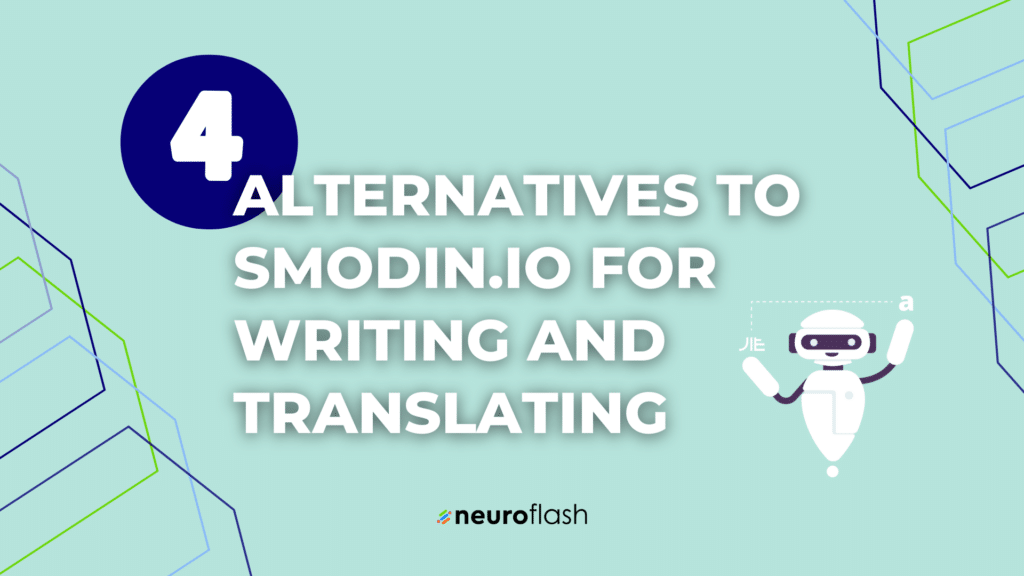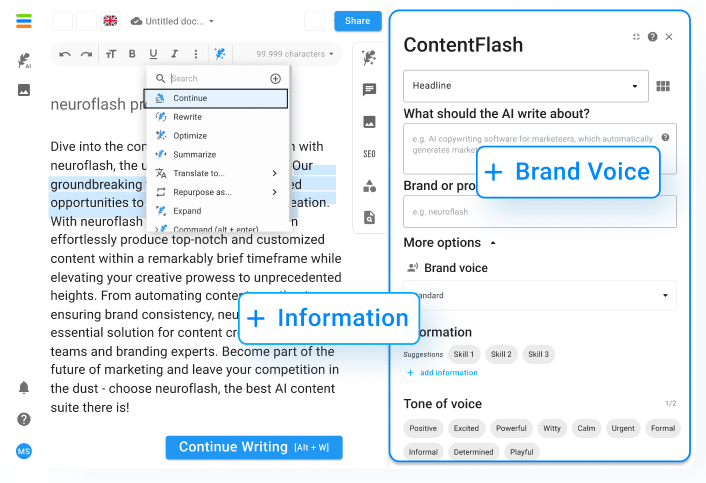If you were excited by the AI chatbot ChatGPT, get ready for the next generation. On Tuesday, March 13, 2023, OpenAI, the company behind ChatGPT, announced the release of the new language model GPT-4. Everything you need to know about GPT-4 from OpenAI is summarized in this article:
Why is the release GPT-4 OpenAI such a big event?
It’s official: OpenAI announced that it is releasing the GPT-4 language model. GPT-4 is an evolution of GPT-3, an open source technology that allows developers to use machine learning to solve programming tasks. The GPT-4 language model is the fourth generation of this technology, and it is one of the most comprehensive and powerful machine learning systems ever developed. With its incredible capabilities, GPT-4 can solve a wide variety of different tasks, including text generation, translation, dialog, and much more. It is a major milestone in the development of AI technologies and AI systems and has attracted the attention of many experts. You can find the GPT-4 announcement from OpenAI here.
What is the technology behind OpenAI's GPT-4?
GPT-4 OpenAI, like GPT-3, is a Generative Pre-trained Transformer (GPT) model designed to generate natural language sentences. It is based on the so-called Transformer architecture model, which was developed by Google and first used in the OpenAI GPT. GPT-4 allows machines to generate natural language text by suggesting words in relation to previous words.
GPT-4 has had a tremendous impact on the fields of machine learning, including Natural Language Processing (NLP), Machine Translation (MT), and Text Generation (TG). It is a powerful tool that can help developers create programs and applications that can generate high-quality text. In addition, it can also be used for automated response systems or chatbots to simulate human interactions.
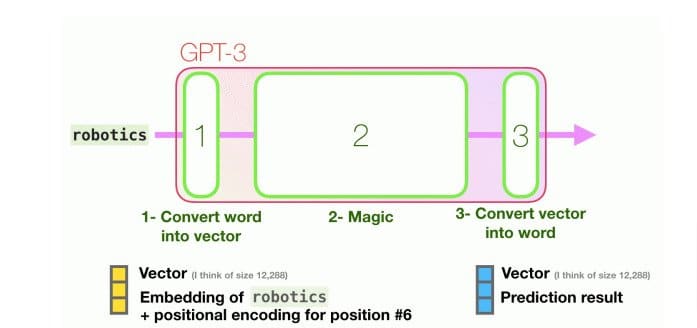
GPT-4 is not only powerful, but also very user-friendly. Since it is already pre-trained, developers don’t have to spend as much time training the model. This means that developers can start building complex applications right away.
OpenAI developed GPT-4 to help machine learning and enable people to create powerful tools. It offers developers new possibilities and integrates easily with existing applications. We are excited about all the great things that will be created with GPT-4!
Do you want to learn more about the size and parameters of AI Model GPT-4? Then click here!
Availability and release date
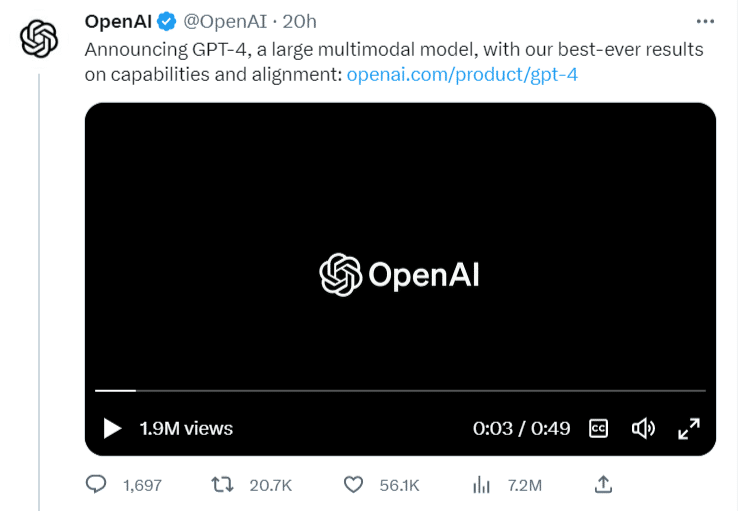
GPT-4 was officially announced for March 13, as Microsoft already confirmed in advance, even though the exact date was not known. As of now, however, it will only be available with the paid ChatGPT Plus subscription. The current free version of ChatGPT will still be based on GPT-3.5.
In doing so, GPT-4 will have an upper usage limit. This limit will be dynamically adjusted by OpenAI depending on demand and system performance in practice. Initially, OpenAI will provide GPT-4 for ChatGPT Plus subscribers 100 messages every 4 hours. In addition, OpenAI reports:
Depending on how traffic develops, we may introduce a new subscription level for the use of GPT-4 on a larger scale. We also hope to eventually offer a certain number of free GPT-4 queries so that those without a subscription can try it out.
OpenAI
Furthermore, a GPT-4 API is available. Most users will have to get on a waiting list. OpenAI reports that the company is trying to give everyone access as soon as possible, but it will probably take some time before all users can be given access to the GPT-4 language model.
What's new with GPT-4?
GPT-4 is the latest addition to AI Systems from OpenAI. GPT-4 is a machine learning model used to understand, interpret and generate natural language. It is designed to deliver more accurate and powerful results than its predecessors. GPT-4 is one of the most powerful and powerful machine learning models developed to date. But what is new about GPT-4 now?

According to OpenAI, this next-generation language model is more advanced in four key areas:
- Creativity: in terms of creativity, OpenAI says GPT-4 is much better at building creative projects and collaborating with users. Examples include music, screenplays, technical writing, and even learning a user’s writing style.
- Visual Input: Al one of the multimodal models, GPT-4 OpenAI can now receive images as the basis for an interaction. This gives the user the ability to ask any visual or voice task. For example, if the GPT-4 chatbot receives a picture of some baking ingredients, it can answer what to do with them. It is currently unknown if videos can also be used in this way.
- Longer context: Longer context also plays a role here. GPT-4 can now handle up to 25,000 words of text from the user. One can even simply send GPT-4 a web link and ask it to interact with the text on that page. OpenAI says this can be useful for creating long content as well as longer conversations.
- Reliability: GPT-4 is more reliable and, according to OpenAI’s internal tests, is able to provide 40% more factual responses while being 82% less likely to respond to requests for objectionable content.
How does GPT-4 compare to GPT-3?
According to OpenAI, the differences between GPT-3 and GPT-4 can be very subtle. However, the difference becomes especially clear when the complexity of the tasks increases. GPT-4 OpenAI is more reliable, creative and able to process much more sophisticated instructions than GPT-3. Here you can see the main differences of the two AI models at a glance:

To understand the difference between the two models, OpenAI developers tested them on various benchmarks, including tests originally designed for humans. While GPT-3 scored only 1 out of 5 on the AP Calculus BC exam, GPT-4 scored 4. On a simulated exam, GPT-4 was in the top 10% of participants, while GPT-3.5 – the most advanced version of the GPT-3 series – was in the bottom 10%:

In addition, GPT-4 OpenAI is a real language talent. While GPT’s English proficiency was already high in the GPT-3 and GPT-3.5 versions (with 70% accuracy), the accuracy increased to over 85% in the latest version, GPT-4. In fact, the new AI model speaks 25 languages better than its predecessor spoke English.

In general, it can be said that GPT-4 OpenAI significantly outperforms existing large language models in terms of performance in traditional benchmarks designed for machine learning models.
Want an exact comparison between GPT-4 vs. GPT-3? Then click here!
How does GPT-4 compare to GPT-3?
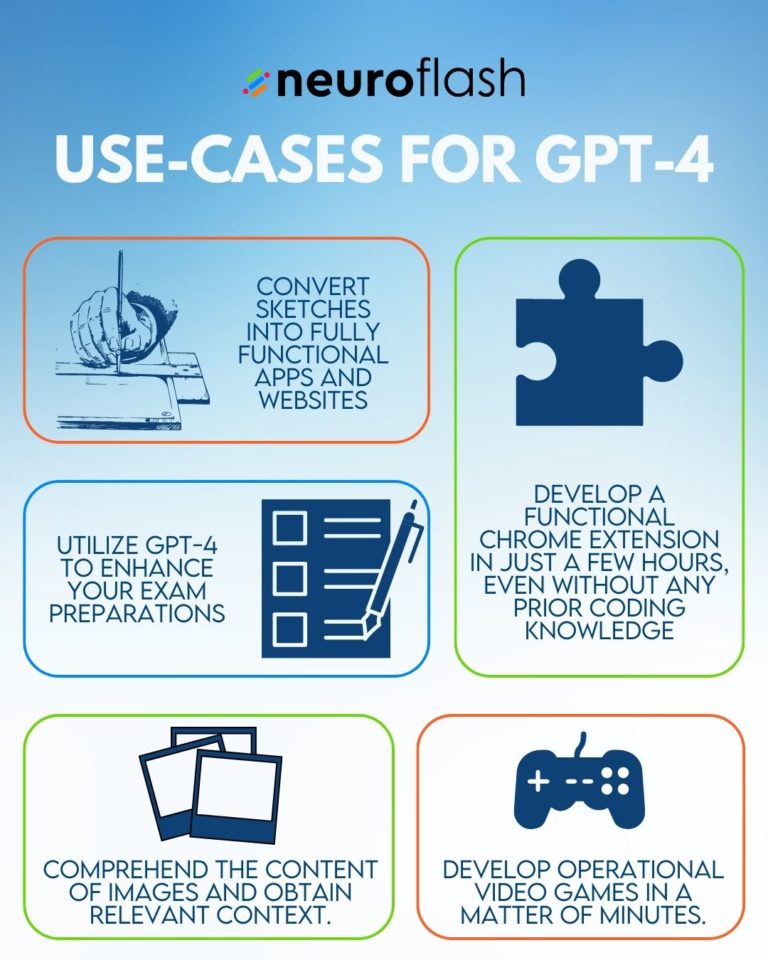
As one of the versatile multimodal models, GPT-4 can be used by OpenAI in many different ways. Already now GPT-4 is used in many areas. We give you some inspiration on how you can benefit from GPT-4:
- Text generation
- Automatic translation
- Automatic code writing
- Entertainment chatbots
- Intelligent virtual assistants
- Automated customer service applications
- Creation of personalized content
- Automatic summarization and extraction of information from text
- Generation of creative ideas for marketing and advertising campaigns
- Improving speech recognition software through better understanding of human language
- Intelligent chatbots for customer service in the e-commerce sector.
- Search engine ranking optimization through automatically generated content with relevant content.
- Automatic writing of news texts based on current events (e.g.: sports results, political developments).
- Creation of personalized recommendations based on user data (e.g.: music recommendations, product recommendations).
Does GPT-4 OpenAI have limits?
Now that OpenAI has officially announced GPT-4, many people will be wondering what the limitations are. Despite its capabilities, GPT-4 has similar limitations as previous GPT models.
Most relevantly, it is still not completely reliable. Artificial intelligence continues to generate partially incorrect facts and make thinking errors. Great care must be taken when using the results of language models, especially in situations where the stakes are high. Therefore, there should always be human verification of the results. Nevertheless, GPT-4 OpenAI is safer than GPT-3 in this respect:
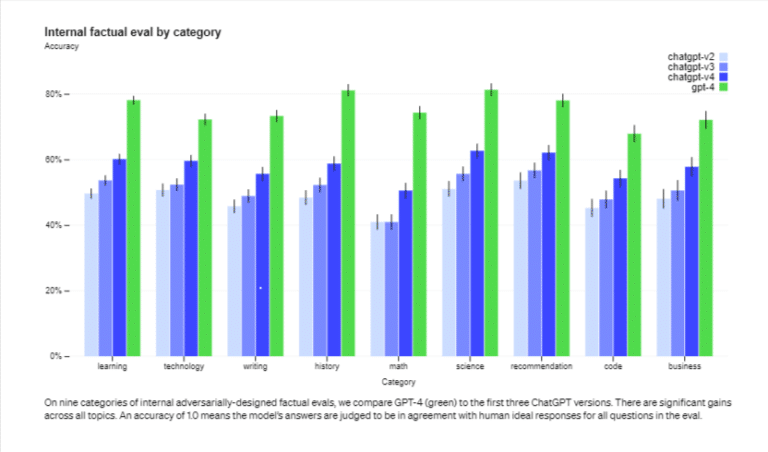
Risks of GPT-4 OpenAI and measures against them
OpenAI reports having worked on GPT-4 to make it safer and better from the start. This includes the selection and filtering of data before training the artificial intelligence, as well as expert evaluations. However, there are still some risks that should be considered when using GPT-4 OpenAI:
- The risk of unethical behavior: Despite testing, there is still a risk that OpenAI’s GPT-4 could provide inappropriate answers to certain questions. This means that there could potentially be undesirable results if the models interact with sensitive information or topics.
- Data dependency: GPT-4 is completely reliant on machine learning and requires a large amount of data to train the models. If the data collection is not complete or is poor, it can lead to poor results when generating text. So far, even GPT-4 OpenAI has limited knowledge after 2021.
- Unpredictable errors: since GPT-4 is mostly based on machine learning, sources of errors are not always avoidable and there is a risk of unexpected output results or faulty logic.
- Misuse: The availability of tools like GPT-4 increases the likelihood of misuse and alienation of personal content without permission from its creator.
Our mitigations have significantly improved many of the security properties of GPT-4 compared to GPT-3.5. We reduced the model's tendency to respond to requests for disallowed content by 82% compared to GPT-3.5, and GPT-4 responds to sensitive requests (e.g., medical advice and self-injury) 29% more often in accordance with our policies.
OpenAI
To address these risk factors, OpenAI has engaged more than 50 experts in areas such as AI adaptation risk, cybersecurity, biorisk, trust and security, and international security to put the model through its paces. The insights gained will be used to test the model’s behavior in high-risk areas that require expertise to assess.
Moreover, GPT-4 OpenAI includes an additional security reward signal to reduce malicious output (as defined in the usage policy) by training the model to reject requests for such content.
What experts say about GPT-4 from OpenAI
Check out some expert opinions on GPT-4 OpenAI:
GPT-4 – my brain is spinning! 


The contents in a nutshell:
Text generation: next level!


Programming



Read out images, understand, describe




Yes, you read that right!
He photographed a notebook.
He uploaded the image.
On it you can see: 6 lines of text, idea of a website with jokes.


Finale: the tax return!!!
Tell GPT-4 it’s a tax accountant.
Copy the tax laws into the system. Formatting: doesn’t matter!
Then inserted a scenario: Couple, married, one son.






What does #ChatGPT4 mean for our small but mighty field of “German at Work”? For #professionallearning? For #adulteducation?
Just now, the long-awaited upgrade, Chat GPT 4, was introduced to the broader public. What’s new?
The most important thing: GPT-4 is no longer a pure language model, but can understand and interpret images in addition to text input, and the text scope has also been expanded and mathematical understanding optimized. The combination of information from images and texts leads to new capabilities (the problem of hallucination still remains, though).
What does this mean for our small but mighty field of “German at work”? #deutschimjob
The interpretation of images promises to expand the range of applications even where there are no formal job descriptions, process descriptions, etc. as text-based data material. So, in the future, we will be able to work in a language-enhancing way not only with the training regulations of winegrowers, but also with the photo of the deep fryer in the food truck. It seems possible to extract text-based training material or vocabulary from pictures of the workplace, machines, etc. alone.
One of the big challenges so far is having to respond to malfunctions or defects in a foreign language at the workplace. Here, too, Chat GPT 4 could provide linguistic support and relief – be it through translations, be it through conversion into simple or easy language, be it through text-to-speech tools, be it through the fact that we can teach and learn German with authentic texts/formats adapted precisely to the workplace. A photo of the defective machine, converted into text, vocabulary, idioms, with which one can continue to work …
Language learners gain autonomy by being able to independently generate explanatory or descriptive texts or, if necessary, audio formats via photos – in German, in the first language, in simple or easy language.
As teachers, this will set us on a path that we will only really grasp when we walk it – curiously, but also analytically sharp and alert in all directions. Here we need spaces for reflection, exchange, networks – and that also means funding, training budgets, structures …
I missed the LiveDemo yesterday from #OpenAI to #GPT4, but luckily Daniel Reimann didn’t. He told me about it and afterward we both laughed a bit maniacally. Because it’s all so unbelievable.
Example 1: Write a Discord Bot
GPT-4 is supposed to write a bot for Discord, but only has old training data. Means specifically, he doesn’t know about the current requirements that the Discord application has for a bot. What does the developer do? He simply copies the entire Python-Discord documentation into GPT-4, like: “Here you go, do you understand now?”
Yes, he understands and programs the bot times just ready.
Example 2: Create a “vision” from a draft for a website
The developer shows a kind of “scratch sheet” – that is really a very simple pen sketch. This image can process GPT4 and turns it into a finished web page. 

Conclusion: Context is everything
You tell the bot what you want it to do and provide the appropriate input. Be it an image for your website or the latest tax guidelines for your new tax bot.
𝗪𝗲𝗹𝗰𝗼𝗺𝗲 𝘁𝗼 𝘁𝗵𝗲 𝗳𝘂𝘁𝘂𝗿𝗲
And this is all just scratching the surface a bit now. The next few weeks will show what all is made of it by us humans.
We talked about it a lot – Now the exponential change is reality
This is all happening so incredibly fast, I really feel like I’m living in a science fiction movie. In any case, I’m not worried that I won’t have anything relevant to tell you.
Will neuroflash integrate GPT-4 as well?
neuroflash always strives to offer users the highest quality. This also includes reacting to new developments and staying constantly up to date. Therefore neuroflash will also integrate GPT-4 in all price plans, as the first European content suite. So you can already benefit from the advantages of GPT-4 technology through neuroflash!
What questions remain in light of the release of GPT-4?
It is obvious that GPT-4 is taking some big steps towards artificial intelligence and ushering in a new era of machine learning. OpenAI has been very excited to announce the progress of GPT-4. But with the release of GPT-4, some unanswered questions remain. For example: How can GPT-4 be made more efficient to improve performance? How can we ensure that GPT-4 is used ethically? How can we prevent GPT-4 from being misused? How can we use GPT-4 to support other areas of machine learning? How can we use GPT-4 to help us solve global problems? All of these questions remain unanswered. We need to keep working on it to experience the full potential of GPT-4.
Conclusion
It’s official: OpenAI has announced the GPT-4! This means that we now have an advanced NLP system that is able to deal with language in a natural way and capture semantic meanings. Thanks to GPT-4, we can now develop even more complex and elaborate applications that improve the user experience and facilitate work.
This new technology promises great advances in NLP research and will certainly help us to develop even more intelligent systems in the future. GPT-4 provides us with a valuable tool to delve into NLP applications and learn more about natural language and semantic meanings. We will be able to solve complex tasks that have not been possible before and we will be able to take applications to a new level.
With GPT-4 OpenAI, we can look forward to smarter applications, better user experiences and more innovation. So it’s time for us to get familiar with GPT-4 and explore all the possibilities that this new technology offers us. We can already hardly contain our excitement about what else the future holds.























